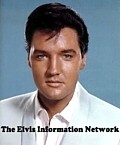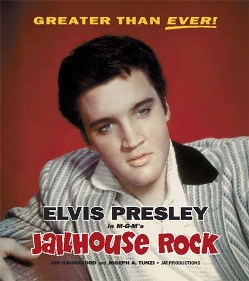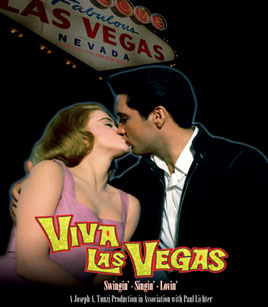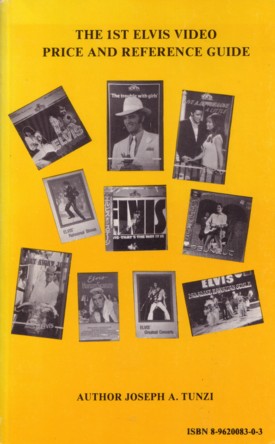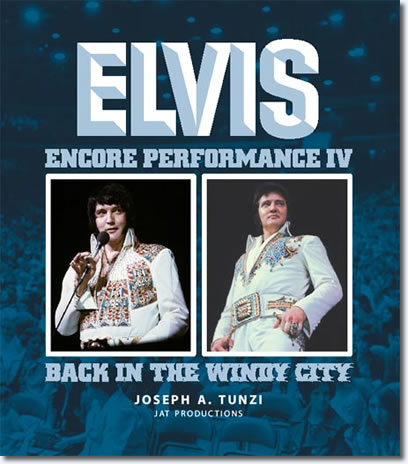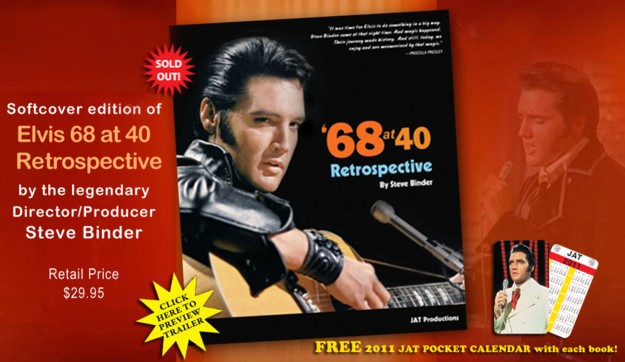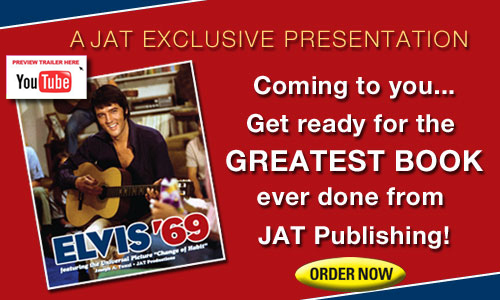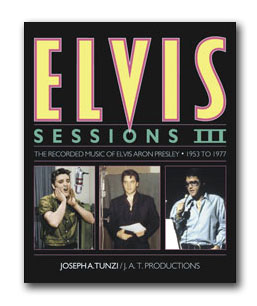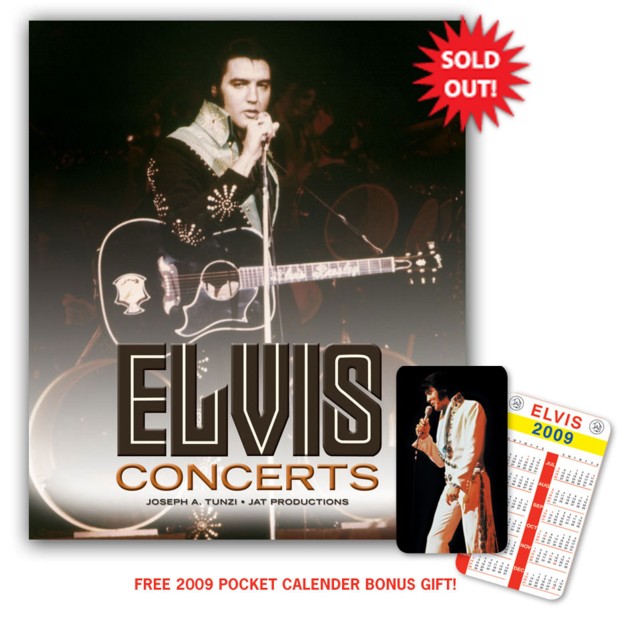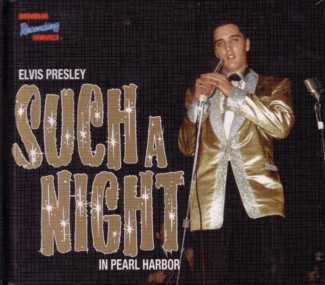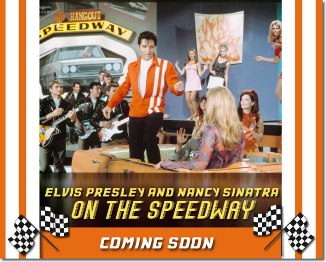 |
 |

Interview conducted between Joseph Tunzi and EIN, August 2012
The EIN Interview (August 2012)Part 1 (of 2 parts)
Introduction: The names Joseph Tunzi and JAT (Publications) Productions need little introduction. Through his company, JAT Productions, Joseph Tunzi has been the most prolific publisher of Elvis books with more than 40 titles released since "The First Elvis Video Price and Reference Guide" in 1988. While JAT Productions is perhaps best known for its many "jumpsuit" books showcasing the King live on stage, it has also released numerous "information" and "photo-journal" books, including the Elvis Sessions series ("Elvis Sessions IV" is due out in 2013), several Elvis film titles, "Elvis No. 1 The Complete Chart History Of Elvis Presley","Elvis '68 at 40 Retrospective", Elvis '71 at 40" and its latest release, "Elvis '69". In addition, JAT Productions has produced various Elvis related DVDs (e.g. the popular "Hot Shots and Cool Clips" series); special vinyl releases (e.g. "Elvis '68 at 40"), and several other items including "Showroom Internationale- The 40th Anniversary Commemorative" menu. Joseph Tunzi is also a collector of rare Elvis recordings, a number of which have been released in recent years ("A Little Less Conversation"; "Maybelline"). In Part 1 of his fascinating (and very long) interview, Joseph Tunzi tells EIN about:
Visit the JAT Publishing website
................The Interview (Part 1)...............
JAT: How does anyone become a fan? Most people become fans of something through a number of different paths. Some people become fans of their favorite sports team simply as a rite of passage from one family member, usually a parent, down to their children. It amazes me over the years how many younger people go down to Memphis during Elvis Week. I can’t say that I went down this same path. In fact, it might be the other way around as my parents grew to have an appreciation for Elvis after I did, although my dad did take a liking to Elvis when “It’s Now Or Never” came out. JAT: I saw Elvis perform on a number of occasions. I believe I documented the shows I saw in a book I did called “Elvis Concerts.” I saw all three shows in Chicago on the June, 1972 tour. The following year I saw Elvis perform in St. Louis, Missouri and in Atlanta, Georgia on the June, 1973 tour. In late 1974, I saw Elvis perform both shows in South Bend, Indiana on September 30 and October 1. I saw Elvis perform in Lake Tahoe in May, 1976. After that, I didn’t see Elvis perform until October, 1976 when I saw both shows here at Chicago Stadium as well as the Champaign, Illinois show and the South Bend, Indiana show during that same October, 1976 tour. I last saw Elvis perform live in Chicago in early May, 1977. The best show I witnessed vocally was the St. Louis show in June, 1973. The most laid-back and casual show was the matinee show in Chicago in June, 1972. JAT: I documented this in my book “Encore Performance IV: Back To The Windy City.” I met Elvis at O’Hare airport here in Chicago in the early morning hours on October 14, 1976. Elvis was flying into Chicago for the two shows he performed to start that tour. I already had purchased tickets to see both shows. I was working part-time at the airport for the air freight forwarder, Shulman Air Freight. My father was a police sergeant, who, among his duties, handled security at the airport. He found out about three hours beforehand that Elvis was coming into the airport and tipped me off and made arrangements for me to meet Elvis and the Colonel. The meeting was pretty much unscripted.
Another police officer lent his badge so that I could be present when Elvis arrived. My father and the Colonel were talking when I got there. They acted as if they had known each other for years. One thing I do remember the Colonel saying was that it was ultimately up to Elvis if he wanted to meet with anyone once he came off the Lisa Marie. I took it to mean that Elvis would sometimes go directly from coming off the plane to the limousine waiting for him. Yes, I did get to talk briefly with Elvis. We both exchanged pleasantries. JAT: Thank you for the compliment. In the 1980s there was a great interest in collectibles. Everything from records, baseball and football trading cards, you name it. Our first book was a tongue-in-cheek look at videos, as the market for videos had been booming over the last ten years. I can remember ¾” video tape machines. In fact, here in Chicago, I paid to have Carmen Trombetta make me a ¾” tape of the 1977 CBS television special “Elvis In Concert” and the NBC “Memories Of Elvis” television special back when they originally aired. Of course, later came Betamax and VHS. Too many of the Elvis books I see coming from new names in the Elvis world seem to think they must have all color photography or that they must have a hard cover. You simply cannot go 0-60 miles per hour when publishing your first books independently. As a business, you will struggle and likely fail. There have been a few individuals who have attempted this short-sighted tactic. The costs associated with photo research, the graphic design, the text, clearances and the printing will kill your business, if you even attempted to go this route. I know this for a fact because one individual in the Elvis world chose to use the same printing place I chose at the time for the printing of my books and they questioned me about how reliable this person was as far as making their payments for the printing costs of their project. I took that to mean they were behind on their printing cost payments. This individual hasn’t done a book on Elvis since. EIN: Do you consider there is a major difference in viewer appreciation if photos are presented in color rather than black & white? JAT: Most people prefer color to black and white. I beg to differ. The beauty of black and white is that it captures the essence of what photography was meant to be. The greatest and the most historic Elvis photos were shot in black and white. Most of the significant photographs from '54 up until '60 were shot in black and white.
EIN: Your '68 @40' book with Steve Binder was a stunner. You have also published the great release "Elvis No. 1 The Complete Chart History Of Elvis Presley" and early on JAT’s history, "The First Elvis Video Price and Reference Guide". Do you have any similar projects, emphasizing information or combining equal detailed text to stunning photos, in the pipeline? JAT: I think “Elvis Sessions IV” will be that book. One of the things we are going to do is combine and update the “Chart History” book information and possibly even the video information and incorporate it into “Elvis Sessions IV.” There will be a narrative text in the book as well. There will be both color and black & white photography incorporated into the book too. There will be a great deal of records and pictures and documents shown throughout the book. JAT: It just came out about a two weeks ago. It tells a story about the monumental year 1969 in Elvis’ career. It’s chock full of newspaper clippings, documents, photos. The book covers Elvis’ recording sessions at American that produced the hits “In The Ghetto” and “Suspicious Minds,” the film “Change Of Habit,” Elvis meeting with Tom Jones in June, 1969, Elvis’ opening night and the press conference that followed , photos of Elvis throughout his initial Las Vegas engagement at the International Hotel and Elvis attending Nancy Sinatra‘s opening night show.
JAT: There is a fairly decent amount of text in the book. Brenda Nies wrote the text with some assistance. She also did the creative design and Jimmy Carpenter did the cover design. JAT: “Elvis Sessions IV” will incorporate most of the post-production sessions for the films, where documentation has been located. It will also incorporate the chart history information and update that information. It won’t just be a book for Elvis fans. This will be a book for music fans, in general. EIN: There were some fabulous photos of Elvis in the studio in "Elvis Sessions III" - have you discovered any more rare photos to include in your new book? JAT: Sessions photos to me are the most historic and are a main priority to try to acquire. It’s important the way he looked and dressed while he recorded. Not only can you listen to Elvis but also see how he looked when he recorded some of his greatest hits such as “Hound Dog,” “Don’t Be Cruel” “Suspicious Minds,” and “Burning Love.” That said, yes we have found some new session photos. JAT: There are some new discoveries. We’ve had access to the William Morris Agency, Variety magazine, Billboard magazine, SAG-AFTRA (Screen Actors Guild - American Federation of Television And Radio Artists), AGVA (American Guild of Variety Artists), the American Federation of Musicians (AFM) offices in Los Angeles, which also covers Las Vegas and Hawaii, as well as Nashville and Memphis. The Al Dvorin archives here in Chicago and Elvis’ personal lyric book, which features lyrics to some very popular songs no one has ever even suggested a rumor that Elvis recorded, rehearsed or performed live. JAT: Absolutely 100% Yes.
EIN: You list plenty of rehearsals in "Elvis Sessions III". Do you know if more tapes have been found? JAT: This is an interesting question. I do know for a fact that several years ago before Myrna Smith of the backing group the Sweet Inspirations passed away that she played for me and told me of some rehearsal recordings that she had from working with Elvis. These dated from 1969-1971 mostly. If you watch the motion picture “Elvis, That’s The Way It Is,” note how Elvis rehearsed. In mid-July, Elvis rehearsed basically with his rhythm section (Burton, Scheff, Tutt, Hardin, Wilkinson, Hodge).
JAT: Stunning is not the proper word. Surprising or interesting would be a closer term I would use to describe. I doubt there’s anyone out there that has a rehearsal by Elvis where he sings ten new songs never before heard. That would be stunning. I guess the word “stunning” is in the ears of the beholder. Yes, I have heard some parts of rehearsals that no one has ever heard before. JAT: I can’t substantiate “Poetry In Motion” and “Ivory Tower.” Those two were from a rumor we received prior to publishing “Elvis Sessions III.” The person who claimed this exists was from what we thought at the time a credible source, though I must say I now have my doubts. This is the reason why both “Ivory Tower” and “Poetry In Motion” were put in their proper place in “The Rumor Mill” in “Elvis Sessions III.” 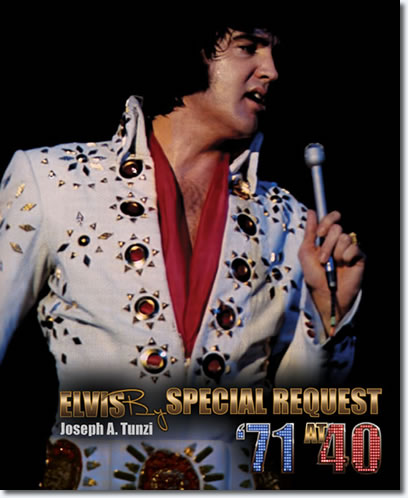
EIN: And in relation to unreleased ‘live” recordings from the 1950s, what songs are you aware of that are in the hands of private collectors? JAT: After the recent leak of the live recording of “I Forgot To Remember To Forget” on Youtube and the release of “A Boy From Tupelo - The Complete 1953-1955 Recordings,” I think we’re pretty much up to date on known live recordings from the 1950s, though I’m sure as the sun rises and sets, that more live recordings by Elvis dating from the 1950s are still out there. When you just think about how many shows Elvis gave from 1954-1957 alone, there’s no doubt that there’s someone out there who has a recording. The most likely scenario is that they don’t really know what they have because the recording was handed down to them from a family member and they either don’t have the proper equipment to play back the recording or don’t have the general know-how to use the equipment properly, if they have the equipment. JAT: David Briggs has a vast tape archive of artists he’s worked with and produced. Part of his archives is a combination of soundboard live shows he worked with Elvis and the micro-cassette recordings he did in 1976. Some of the soundboards he has are incomplete. The micro-cassette recordings were recorded by David just for historic knowledge of recording with Elvis at Graceland’s Jungle Room. Elvis was fully aware of the recordings. I don’t think David could have foreseen that those sessions at Graceland would be Elvis’ last recording sessions. The micro-cassette machine was battery operated. David has located some of the tapes but many have simply been misplaced. JAT: Generally speaking, I think FTD is doing a outstanding job. Yes, I might not have released things in the same order as what Ernst and Roger have, but for the most part I don’t have any qualms about what FTD has released. I don’t think FTD necessarily should have released the “Closing Night” show from September, 1973 and I really don’t think that they should have released some of the comments that were later removed from second pressings of the “From Sunset To Vegas” FTD. I would like to see FTD release a few things. Those would be the August 3, 1969 show as well as the opening and closing shows from the January / February, 1970 engagement. Besides those three shows, I would like to see FTD release a show similar to the show I saw in St. Louis on June 28, 1973. It had a powerful set list and Elvis was on his game.
We published the set list in our “Elvis Concerts” book: JAT: I think an approach similar to what FTD did with the “Dixieland Rocks” release would be worthwhile, be it that they only choose the best performances from a specific tour where they have a lot of shows on soundboard. I know FTD tries to mix it up some, as most of the soundboards they have are from 1974 and onwards. If I had to pick an individual show, it probably would have to be the final concert from Indianapolis, Indiana on June 26, 1977 only because of the historical significance.
JAT: Yes, Joe and I have been working on several projects that I think a lot of fans will be pleased with. I will not divulge information, as I wish to respect the manner in which Joe wants to announce his product. JAT: Personally, I’m not too keen on material from 1977. It’s hard to look at it objectively and say that Elvis looks and sounds great. I think had Todd Morgan of EPE not passed away, several years ago, I think we would have either already had a video release of “Elvis In Concert” in some capacity. It likely wouldn’t have been sold in stores and it likely would have been a limited production run of maybe 3,000-5,000 copies to appeal to those dyed-in-the-wool fans who love Elvis no matter what. I think the plan was after the release of the deluxe editions of the “’68 Comeback” and the “Aloha From Hawaii Via Satellite” DVD, you would have seen an “Elvis In Concert” deluxe edition. This likely would have meant a tasteful re-edit of the original show. I think we would have gotten a good majority of the outtakes as well. But like I said, Todd passed away, and this project seemed to stall.
JAT: I wasn’t influenced by what others were doing. We’ve tried to stay within our budget. I think what really matters in the publishing is what is on the pages, not whether or not it’s in soft cover or hardback. Sometimes getting too caught up in what I’d call the bells and whistles will ultimately price yourself out of sales. I also think we have a great team of people who have worked on our product. EIN: What about the argument that hardcover books are more durable. Fans like to look through photo books on a regular basis and in softcover format they can quickly become dog eared.
JAT: Whether it's hardcover or softcover, both, if properly printed and assembled, can hold up remarkably well. I don't think it's necessarily an issue of hardcover versus softcover. For example, Ernst's hardcover release of "A Life In Music" practically had the pages falling out after minimal wear. I think "Elvis Sessions III" has been as durable, if not more. Some publishers will swear by hardback and others will recognize that both can be equally as durable. I also think it depends on how well fans protect and take care of their books. There's only so much a publisher can do to make a book durable. EIN: Some fans complain that the price of photo books is too high. What is your response to this? JAT: We’re now one of, if not the cheapest publisher. This applies both wholesale and retail. I know this was one of the biggest complaints against us for many years, but I think we have addressed many of our critics harshest critiques of our books. For many years it was black & white vs. color. Did that. Soft-cover vs. hard back. Did that. I think if you compare the costs of books between what we’ve put out recently and what FTD has put out or Erik Lorenzten or Joe Pirzada, I think we stack up pretty well as far as both wholesale and retail cost.
End of Part 1 The concluding part in Josesph Tunzi's engrossing interview will appear on EIN next week. In Part 2, Joseph discusses:
Copyright the Elvis Information Network.
. .
|
|
